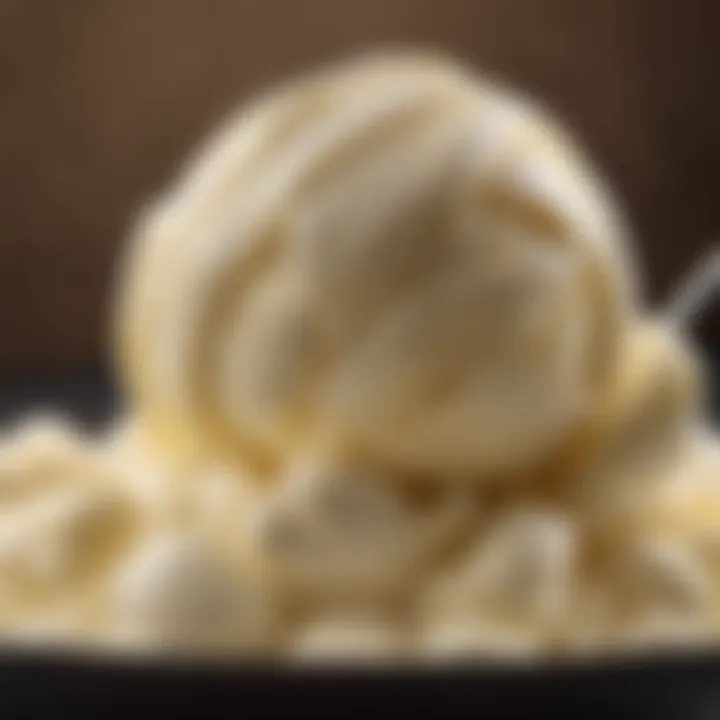The Art and Science of Ice Cream and Gelato Making


Intro
Ice cream and gelato are culinary treats cherished by many across the globe. Both offer a soothing delight during hot days or as a sweet finish to a satisfying meal. While they may appear similar at first glance, a deeper examination of the production processes, ingredients, and textures reveals a complex relationship between the two. This guide aims to dismantle the layers of ice cream and gelato making, making it accessible for home enthusiasts and busy professionals alike.
The journey into the world of frozen desserts begins with an understanding of their fundamental differences. The significance of these differences plays a central role in a maker's choices from selection of ingredients to choosing the machinery for production. Not only will we explore essential ingredients and their functionalities, but also the equipment that plays a pivotal role in delivering the final product.
Through this narrative, individuals will walk away equipped to craft their own ice cream and gelato at home. We will elucidate the methods involved, including tips for both traditional techniques and modern approaches, and emphasize the flavor potential that comes from creating these desserts from scratch.
With an ample knowledge of understanding ice cream and gelato, readers can take pride in delighting friends and family with their creations. Approach this guide as both a learning tool and inspiration, empowering your confidence in developing these intricate but rewarding indulgences.
Recipe Overview
Creative Name: Creamy Dreams Ice Cream
- Yields: 4 Portions
- Prep Time: 30 minutes
- Cook Time: 30 minutes
- Difficulty Level: Medium
- Main Ingredients:
- Heavy cream
- Whole milk
- Granulated sugar
- Egg yolks
- Vanilla extract
Step-by-Step Instructions
- Start by boiling the milk and heavy cream in a pot over medium heat. Stir regularly to prevent sticking.
- In a separate bowl, whisk together the granulated sugar and egg yolks until the mixture becomes pale and slightly thick.
- Slowly pour the hot milk mixture into the egg yolk mixture. This technique is tempering, which helps in preventing the eggs from scrambling.
- Return the combined mixture back into the pot over medium heat. Stir constantly until it thickens to a custard-like consistency, which takes around 10-15 minutes.
- Once thickened, strain the mixture through a fine sieve into a bowl to ensure smoothness.
- Add in the vanilla extract and refrigerate the mixture until it's completely cool.
- Once cooled, churn it in an ice cream maker according to the manufacturer's instructions.
- Transfer to an airtight container and freeze for at least 2 hours until set.
Time-saving Strategies
- Utilize a food processor to handle the mixing of your ingredients if you lack time for whisking.
- Consider using store-bought vanilla silk to speed up your preparation.
Nutritional Information
- Caloric Total per Portion: Approximately 300 - 350 calories
- Macros:
- Beneficial Nutrients: Rich source of calcium from milk and healthy fats, contributing to nutrient absorption and energy.
- Proteins: 5g
- Fats: 23g
- Carbohydrates: 25g
Quick Cooking Tips
- Investing in an ice cream maker can significantly enhance your quality and efficiency. Machines like Cuisinart ICE-21 lead to quicker freezing times and consistent texture.
- While multitasking, keep an eye on the cream as it heats and be ready to divert your focus at the tempering stage, which is critical.
- Swapping heavy cream for Greek yogurt can yield a lighter alternative higher in protein.
Related Recipes & Variations
By mastering the basics, additional variations can be explored such as:
- Salted Caramel Gelato for a sweet, salty contrast
- A Fruit Sorbet as a refreshing, dairy-free alternative
- Chocolate Ice Cream using cocoa powder or melted chocolate for an indulgent twist
Engage creatively; you may share your own their personalized techniques on online platforms. Platforms like reddit.com have communities where ice cream lovers share insights worth exploring.
Foreword to Frozen Desserts
Frozen desserts, particularly ice cream and gelato, serve as delightful treats enjoyed worldwide. This article intends to delve deeper into their allure, the cultural significance they hold, and their fundamental differences. Such knowledge not only enhances the enjoyment of these treats but also enriches one’s understanding of culinary arts. By exploring the intricate details of making ice cream and gelato, both novice enthusiasts and seasoned cooks can achieve impressive results in their kitchens.
The Appeal of Ice Cream and Gelato
The appeal of ice cream and gelato extends beyond their delightful flavors. These frozen desserts provide a unique sensory experience. The differing textures—a creamy ice cream versus a denser gelato—add to the enjoyment. Vanilla, chocolate, or wild berry, every taste brings its distinct pleasure.
Furthermore, frozen desserts evoke memories of childhood summers, gatherings, and celebrations. They serve as a common ground in social interactions. The sheer joy of choosing a flavor, glancing into a freezer and having the anticipation of relaxation is cherished by many.
The health aspect also plays a note with modern consumers. Today, individuals can opt for alternatives, low-sugar options, or dairy-free variations, making these treats available to a broader audience. This versatility has significantly fueled their enduring popularity, opening fresh potential in the industry.
It can make you feel both comforted and invigorated.
Cultural Significance
Frozen desserts hold cultural significance across the globe and reflect regional traditions and histories. Ice cream has become a staple in the United States, while in Italy, gelato stands as a proud form of artistry bound by local heritage. Vendors serve it fresh from their carts on warm days, becoming an indispensable part of Italian life.
In Asia, variations such as mochi ice cream showcase innovation, combining traditional sweets with modern techniques. The furor around these goes beyond just the tactile enjoyment. They often initiate conversations and forge connections among communities.
Their preparation frequently accompanies various histories of tradition and art. For instance, artisan local shops craft their gelato through practices passed down through generations. This engagement highlights not only culinary skill but also each culture’s unique narratives.
Overall, these frozen desserts are a symbol of communal values, making them significant tokens of shared experience. They invite exploration, experimentation, and tailored tastes, meeting both the palate and cultural fabric of societies.


Understanding Ice Cream and Gelato
Ice cream and gelato are not only delightful treats but also products of intricate techniques. To grasp the mastery behind these frozen delicacies, one must understand the fundamental elements that distinguish them. This section highlights the unique traits and benefits intrinsic to both, allowing culinary enthusiasts to appreciate the creativity involved in their production.
Defining Ice Cream
Ice cream, classified as a frozen dessert, typically consists of a base made from cream and milk. The texture is characterized by a rich creaminess resulting from a higher fat content, usually at least 10 to 20 percent. In addition, various sugars contribute to its sweetness, while air is incorporated through the churning process.|An essential element of ice cream is its volume; it often contains more air than gelato, leading to a lighter feel in the mouth. The freezing process of ice cream involves quick freezing, maintaining a softer texture when served. Ice cream is versatile, accommodating a wide variety of flavors and mix-ins. This versatility has made it amerce a go-to treat across cultures.
Defining Gelato
Gelato is often mistaken for ice cream, yet it is distinct in both composition and production methods. It usually contains less cream, which results in a significantly lower fat content—around 4 to 9 percent. More milk is used in gelato recipes, which gives it a denser and creamier texture. One key to gelato’s notable smoothness is the processing of less air into the mix. Therefore, gelato has a lower air volume than ice cream, creating a richer and more intense flavor.
Gelato presents a slower freezing process, which allows flavors to manifest more distinctly. This craft urges a careful balance of ingredients and meticulous handling to ensure perfection in each batch.
Overall, recognition of the fundamental definitions of ice cream and gelato is beneficial for anyone interested in creating these beloved desserts. Each type offers unique experiences in taste and texture, making a substantial impact on the culture of frozen delights.
Key Differences Between Ice Cream and Gelato
Understanding the critical differences between ice cream and gelato is essential in the realm of frozen desserts. Both frozen confections bring joy to many, yet their characteristics, taste, and mouthfeel set them distinctly apart. These differences are not just culinary nuances; they affect both the crafting process and the serving experience.
Ingredients and Composition
Ice cream and gelato diverge primarily in their ingredient composition. Ice cream generally contains a higher fat content, owing largely to its base of heavy cream. This results in a rich and, at times, creamy texture. The key formulation calls for at least 10% milk fat according to United States standards.
Gelato, finds itself leaning towards a lesser cream ratio, often utilizing more milk than cream. This unique formulation leads to a fat content that usually ranges between 4% to 9%. The lower fat not only influences the ratio of flavor to fat but also allows for more intense flavors to shine through. Another component to consider is the sugar balance, which can differ significantly between the two. Furthermore, the absence of air—or the incorporation of less air—in gelato allows it to deliver a fuller flavor profile, significantly influencing the overall tasting experience.
Texture and Mouthfeel
The texture and mouthfeel of ice cream and gelato also diverge. Ice cream possesses an airy lightness primarily due to the incorporation of more air during the churning process. On the other hand, gelato is churned at a slower speed, integrating less air. This essential technique results in a denser product.
One may notice gelato's silkiness on the tongue, a sensation that contributes to its unique appeal. The formulation of proteins and sugars in frozen desserts impacts these sensations too. For instance, when gelato melts, it releases flavor remarkably quicker, which enhances perception during tasting. Ice cream, with its creamy quality, lingers longer and produces a different, sometimes less intense, flavor burst on the palate when experienced.
Serving Temperatures
Temperature also plays a pivotal role in distinguishing these frozen desserts. Ice cream is typically served at a colder temperature than gelato, often directly from the freezer at 0°F to -10°F (-18°C to -23°C). This results in a firmer texture that may require waiting for a brief period before scooping.
Conversely, gelato is served at a slightly warmer temperature, usually around 10°F to 22°F (-12°C to -6°C). This higher serving temperature aids the creaminess and pleasant mouthfeel while enhancing flavor delivery. If improperly enjoyed, ice cream requires some adjustment after removal from the freezer; gelato is ready for pleasurable consumption without delay.
Understanding these fundamental differences helps chefs, consumers, and enthusiasts fine-tune their choices. Whether creating exquisite frozen desserts at home or in commercial environments, recognizing these differences assists in achieving the desired balance of texture, flavor, and experience.
These insights into ingredients, texture, and temperature are pivotal for fully appreciating what each dessert has to offer.
Essential Ingredients for Ice Cream and Gelato
Understanding the essential ingredients of ice cream and gelato is crucial to mastering the art of making these beloved frozen desserts. The right components not only influence the flavor but also affect texture and overall enjoyment. Each ingredient serves a specific purpose, contributing to quality and taste. By grasping the significance of these ingredients, culinary enthusiasts can create high-quality frozen treats that rival commercial offerings.
Primary Components: Cream, Milk, and Sugar
The fundamental components of ice cream and gelato include cream, milk, and sugar. Cream, typically rich in fat, creates a creamy texture that is essential in ice cream. Ice creams generally have higher fat content, which contributes to a richer mouthfeel. Milk, on the other hand, provides the base for most frozen desserts. It also impacts how smooth the end result will be. Combine these two with sugar, the sweetening agent, and you will find a balance that creates an appealing treat.
Sugar serves more than a sweetening role; it also lowers the freezing point of the mixture. This keeps ice cream soft and allows for a pleasurable texture. Different forms of sugar, like granulated sugar, honey, or corn syrup, can be used in varying amounts for desired results.
It is also important to note that the proportions of these components can significantly change the final product. For instance, substituting part of the cream with milk lessens the richness while being more economical.
Flavoring Agents
Flavoring agents vividly impact the personality of any frozen dessert. They can range from traditional vanilla and chocolate to unique ingredients such as lavender or matcha. Real fruit purees, nuts, coffee, and even spices can be adjulated to incorporate diverse flavors. The choice of flavoring often reveals much about the maker’s creativity.
Quality flavoring agents can enhance a relatively simple mixture, adding depth and character. Using fresh, high-quality ingredients results in a superior end product that satisfies even the most discerning palates. It is essential to consider the concentration and balance of flavors, and testers may find that some ingredients may need integrating in larger or smaller amounts.
Equipment for Making Ice Cream and Gelato
The ability to create high-quality ice cream and gelato hinges not only on the ingredients used but also significantly on the equipment involved in the process. Each element of this equipment has a specific role and can affect the overall outcome of the final product. Choosing the right tools enhances efficiency, skill mastery, and ultimately the flavor and texture of the frozen dessert. Understanding what is available is crucial for anyone looking to embark on this culinary journey.
Ice Cream Makers
The cornerstone tool in ice cream and gelato making is undoubtedly the ice cream maker. These devices provide the necessary components for rapidly churning the mixture while incorporating air, which is critical in achieving a fluffy, smooth texture. While several types exist, you can categorize them into three main options: manual, electric, and compressor machines.
- Manual Machines: Often less expensive, manual machines generally require a bit more effort during the churning process. They might come with a hand-crank operational method that’s satisfying for those who enjoy immersive culinary experiences.
- Electric Machines: More popular today, especially in home kitchens. These machines are user-friendly and can range from affordable home units to high-end models. Many have automatic features that maintain the freezer within the churn, ensuring the mixture stays at the necessitated low temperature throughout the process.
- Compressor Machines: Designed for serious enthusiasts, compressor machines incorporate a built-in freezing function. This technology allows for continuous ice cream making, as there's no need to store a separate cooling bowl in the freezer ahead of use. However, these devices are sometimes pricey and often occupy more counter space.


When selecting an ice cream maker, consider your personal preferences and production needs. Each type has its pros and cons; for instance, your budgetary constraints might limit wireless capabilities, or you may desire the hands-on tradition offered by manual devices. It's essential to find the right fit—not just for the device itself but also for your culinary ambitions.
Alternative Methods: No-Churn Techniques
For those interested in creating frozen desserts without the commitment to specific machines, no-churn techniques offer versatility and immediate options. This are ideal for individuals who enjoy ice cream occasionally. No-churn ice cream methods typically involve combining heavy cream, sweetened condensed milk, and flavor components.
These techniques simplify the process significantly as they eliminate the need for constant churning. Below are common approaches:
- Whipped Cream Base: This method requires whipping heavy cream until stiff peaks form, followed by gently folding in sweetened condensed milk and desired flavorings. The mixture can then go directly into a container for freezing.
- Blending Ingredients: Some recipes involve a blender combining heavy cream with flavor ingredients until smooth. It's effective for creating small batches quickly.
Although no-churn recipes may not have the same texture as those produced in an ice cream machine, they do present an easy and accessible choice for those new to making frozen delights. That said, the flavor options remain vast and can entice the interested maker.
Storage and Freezing Tools
Storing homemade ice cream and gelato correctly is essential to maintain optimal flavor and texture. Using the appropriate containers and tools can help extend the life of your creation and keep it as delicious as possible. Key elements to consider include:
- Containers: Airtight containers prevent ice crystals from forming and minimize flavor loss. Silicone or plastic tubs with locks create a tighter seal compared to regular glass jars.
- Freezer Temperature: An ideal freezing temperature of -20°F (-29°C) aids in ensuring a firm, solid state for your creations. Whilse some freezers might not achieve this, where possible, monitor options closely.
- Ice Cream Scoopers: Having a dedicated ice cream scoop ensures smoother serving. Specialized scoops tend to have ergonomic designs, providing a comfortable grip while easily carving through the frozen treats.
In sum, investing time or resources into understanding your storage options is profoundly beneficial in preserving delicate textures and flavors from your ice cream and gelato making adventures.
Making ice cream is not merely about the mixing; it's just as importantly about correctly protecting the results.
This step covers essential equipment while helping to navigate the options and implications. The next sections continue operating within this framework, advancing your understanding further.
Basic Process of Making Ice Cream
The process of making ice cream is foundational to crafting this beloved frozen delicacy. Understanding the methods involved allows both professional chefs and home cooks to create various flavors and textures to delight any palate. Grasping this process also ensures consistency in quality and taste, which is essential when aiming to impress guests or satisfy family cravings.
Mixing Ingredients
The initial step in making ice cream involves combining the main ingredients: cream, milk, sugar, and any flavoring components. This crucial phase sets the stage for the final product's flavor and consistency. It's essential to choose high-quality components because they significantly impact the final taste.
- Cream and Milk: The ratio between cream and milk can determine the richness of the ice cream. Using more cream yields a creamier dessert, while more milk can create a lighter version.
- Sugar: Apart from providing sweetness, sugar plays a pivotal role in controlling the freezing point of the mixture. It helps ensure a smooth texture by preventing the formation of large ice crystals during the freezing process.
- Flavoring Agents: Nuances such as vanilla extract, cocoa powder, or fruit puree should be blended into the base to achieve desired flavors. Each ingredient should be carefully measured to maintain balance in the mixture.
- Stabilizers and Emulsifiers: These ingredients are added to improve the texture and scoopability of the finished product. They assist in creating a smooth mouthfeel by maintaining an even distribution of fats and preventing separation.
Churning Process
Once mixed, the ice cream base goes through churning. This stage is vital because it incorporates air and breaks up ice crystals. The amount of air integrated plays a crucial role in achieving lighter and smoother ice cream. It is important to note:
- Equipment: Ice cream makers are commonly used for this purpose. They typically churn the mixture while it's being frozen, promoting a creamy texture.
- Timing: The duration of churning is critical. Under-churning will lead to a dense final product, while over-churning can create a more aerated texture which might not be as rich.
“The churning process determines both the aeration and overall texture, making careful monitoring vital.”
Freezing and Aging
Following the churning process, the mixture is then frozen. However, this stage commands meticulous attention as well.
- Rapid Freezing: Cooling the ice cream quickly after churning ensures minimal ice crystal formation, leading to a smoother final product.
- Aging the Mixture: Allowing the mixture to age in the freezer for several hours or overnight enhances the flavors. This resting period enables ingredients to meld, enriching the taste profile.
Deliberating through both freezing and aging contributes fundamentally to achieving a sophisticated mouthfeel. Together, these stages form the crux of the ice cream-making process, combining art and precision to produce a delightful frozen treat.
Basic Process of Making Gelato
Making gelato is both a science and an art. Understanding the fundamental processes involved is crucial for anyone who wants to create authentic gelato at home. The subtleties in each step can significantly impact the final product, from flavor depth to texture. With gelato, careful consideration is given to how the mixture is developed, the aeration during churning, and the serving temperatures. Each element connects and functions as a single unit to produce a smooth, rich treat that stands apart from other frozen desserts.
Crafting the Mixture
Creating the mixture is the foundational stage of making gelato. The mixture starts with high-quality ingredients, primarily milk, cream, and sugar. Other elements, such as flavorings and stabilizers, add depth and enhance the final taste. Milk typically serves as the base, but the emphasis should be on higher milkfat content. This contributes a creamy mouthfeel while keeping the gelato lighter than ice cream.
Precision is key. All components have a specific role. Sugar does not just sweeten the gelato; it directly influences the texture and freezing properties. This controlled dissociation ensures a smoother texture. All parts must be blended to create a combination that fulfills the balance of both taste and texture.
Lower Air Incorporation
In gelato making, where lower fat content is balanced with a specific air incorporation, the process is delicate. The less air this mixture holds compared to traditional ice cream is vital. This minimal incorporation not only traps and preserves the creaminess but also retains that robust flavor.
This lower volume of air results in denser gelato. During the churning process, the gelato base is agitated. This removes excess air, allowing richer flavor profiles to expand while forming a silky, smooth finish. Too much air can lead to an undesirable, lightweight, icy texture that dilutes the tasting experience.
Optimal Serving Conditions
The ultimate enjoyment of gelato hinges on serving it under ideal conditions. It needs to be soft, not overly frozen to achieve the best sensory experience. Optimal serving temperature for gelato is generally around -10°C to -12°C. This allows the flavors to be fully appreciated and ensures a smooth melt on the palate.


Furthermore, serving gelato requires proper storage techniques. If it is too cold, the flavors will be muted and indistinct. The gelato should be removed from the freezer and allowed to warm slightly before serving. This will elevate its taste and texture, encouraging an enlightening experience with every bite.
Always remember: Enhancement of flavor and texture in gelato comes not just from ingredients but from how it is served.
In summary, mastering the basic process of making gelato signifies understanding its core. From shaping the mixture through proper air management to ideal serving practices, every action counts toward developing an exceptional gelato experience at home. Thus, this process is as crucial to the craft as the ingredients themselves.
Flavor Variations and Innovations
The world of ice cream and gelato is a canvas for culinary creativity. Understanding Flavor Variations and Innovations is crucial for both enthusiasts and professionals in the frozen dessert scene. The flavors you choose can significantly impact the overall experience. From traditional selections to contemporary innovations, the choices shape the desire of consumers and their relation to the desserts.
As chefs and home makers explore these options, it's beneficial to consider seasonal ingredients, regional preferences, and dietary trends. This flexibility can engage a broader audience, often leading to satisfaction and demand for unique options not found in commercial products.
Classic Flavors
Classic flavors represent the backbone of the ice cream and gelato industry. Favor known flavors such as vanilla, chocolate, and strawberry persistently remain popular. Their widespread appeal accounts for much of their cottage food fame. These flavors not merely stand the test of time, they provide a base to build innovative creations.
- Vanilla: A universally beloved flavor; its subtle notes appeal to many journey into taste.
- Chocolate: Rich and deeply satisfying, great for mixing with other flavors.
- Strawberry: Often made with fresh fruit, it captures the essence of sweet summer days.
In addition to taste, classic flavors often showcase the texture and quality of the product. Those flavors help in illustrating the skills of the maker. Well-prepared vanilla can unveil the vibrant flavor of quality ingredients, such as vanilla beans or organic cream. For those entering this field, mastering classic options can form a foundation of knowledge for future explorations.
Modern Twists and Fusion Options
The modern culinary scene embraces innovation and an adventurous spirit. Today, the creative possibility with flavorings comes through fusions of traditional tastes with unexpected ingredients. Techniques often combine elements from various cuisines and soccer favors to create exciting new sensations.
Some profound examples include:
- Salted Caramel: Merging sweetness from caramel with a savory pinch of sea salt has become immensely popular.
- Saffron and Pistachio: Not only these ingredients stand out in flavor, they also add visual appeal with rich colors.
- Spicy Mango: A crisp chili incurs a hint of heat and zest to contrast tropical sweetness.
Overall, the ability to experiment with such innovative combinations allows entrepreneurs and chefs to distinguish themselves. As palates evolve, driving consumers towards authenticity and uniqueness becomes key for the future of frozen desserts. This opens vast opportunities in both store and home kitchens while focusing on empathy towards varying wellness concerns, likes, and expanded gastronomic experiences.
Flavors unveil identity. Each scoop tells a story and resonates more deeply than merely satisfying a sweet tooth.
Creating a rich amalgamation of classic and modern flavors is pivotal to enticing the next generation of dessert lovers.
Health Considerations
Understanding health considerations is vital in the context of making ice cream and gelato. As these frozen treats can be part of many diets, recognizing their nutritional implications is crucial for various consumers. This section will shed light on how both ice cream and gelato can fit into a healthy lifestyle and what to keep in mind when making them at home.
Assessing Nutritional Value
Evaluating the nutritional value of ice cream and gelato involves examining their primary ingredients. Ice creams typically contain higher fat content due to the use of more cream, while gelatos often incorporate a greater proportion of milk.
- Caloric Content: Ice cream usually contains more calories per serving because it is denser in fat and sugar.
- Sugar Levels: Both desserts can have high sugar content, which contributes to their sweetness.
- Protein and Fiber: The addition of flavorings, such as fruits or nuts, can increase protein and fiber, thereby creating a more balanced treat.
Making frozen desserts at home allows individuals to monitor these components better. You can choose lower-fat milk or alternate sweeteners to optimize your health outcomes. Awareness of portion size is also key to enjoying these delights without compromising health.
Allergy Awareness
As manufacturers and home cooks create diverse flavor profiles, understanding allergies related to frozen desserts is essential. Ice cream and gelato can contain several allergenic components, which could pose risks to some consumers.
- Dairy Allergies: Lactose intolerant individuals may experience discomfort when consuming traditional ice creams and gelatos. Options like dairy-free ice creams made from almond or coconut milk are available but best to check labels.
- Nut Allergies: Ingredients like chopped nuts or nut extracts can be potential allergens. Therefore, being aware of ingredient lists helps consumers avoid adverse effects.
- Cross-Contamination Risks: In addition to ingredients, contamination during the manufacturing process can lead to allergen exposure. Understanding where and how the desserts are made can help regarding allergy-friendly options.
Staying informed about the nutritional aspects and possible allergies of ice cream and gelato enhances your culinary experience while ensuring a safe enjoyment of frozen desserts.
By keeping these health considerations in mind, both enthusiasts and casual makers can elevate the art of crafting ice cream and gelato at home, making informed choices beneficial to their long-term well-being.
Finale: The Art and Science of Frozen Desserts
The journey into the world of ice cream and gelato making is one that combines technical knowledge with creativity. Each aspect, from selecting ingredients to mastering equipment, contributes significantly to producing high-quality frozen desserts. Understanding the core differences between ice cream and gelato helps in appreciating the uniqueness of both. This awareness allows makers to replicate these textures and flavors accurately, ensuring a satisfying experience for both the creator and the consumer.
The process of making ice cream and gelato is not overly complicated, yet it requires an appreciation for detail and a willingness to experiment. Beyond the basic recipes, exploring diverse flavors and techniques opens a myriad of possibilities. This exploration can elevate simple ingredients into innovative culinary treats that reflect personal tastes and cultural influences.
Continuing to push boundaries invites continuous learning. Each batch made, whether successful or less so, imparts knowledge. Engaging in the craft cultivates a deeper connection to these frozen sweets, grounding the experience in both art and science. Remember, the beauty lies in the shared experiences of enjoying these creations, as they often lead to cherished memories.
Recap of Key Points
- Understanding Differences: Ice cream is often richer, with a higher fat content, while gelato tends towards a denser and creamier consistency with less air incorporation.
- Ingredients Matter: The choice of core ingredients—cream, milk, sugar, flavorings—dictates the quality of the final product.
- Methods of Production: Mastery of churn time and freezing methods significantly influences texture and flavor retention.
- Health Considerations: Awareness of nutritional profiles and allergy information is crucial for safe consumption.
Encouragement to Experiment
It’s essential to cultivate creativity in the kitchen when making ice cream and gelato. Start with standard recipes, but don’t hesitate to play with ingredients. Try incorporating fruits, herbs, or spices that may not commonly feature in traditional desserts. This is a journey of self-expression; the results may surprise you.
Creating frozen treats at home opens ways to adjust sweetness, fat levels, and flavors to suit personal or dietary needs. Mixing and matching flavors can also reflect seasonal availability—think fresh berries in summer or warm spices in winter.
So grab an ice cream maker or another method of your choice, and don't fear trial and error. With each attempt, your understanding and skills will deepen, infusing both novelty and nostalgia into your frozen dessert endeavors. Above all, enjoy the process of experimenting, leading to endless possibilities in the vibrant world of frozen desserts.







